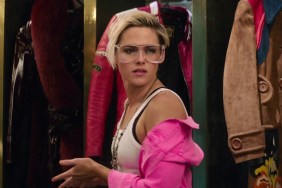
The Goetz Brother’s remake of MARTYRS is really rather good.
I did not hate the MARTYRS remake.
I fact, despite its framework familiarity and ample bloodshed (still nowhere near as gruesome as the original), I was actually moved by it.
Because one thing this remake has going for it that Pascal Laugier’s shattering French Canadian original did not is that it has a soul.
Ironic, considering both films’ surface purpose is to explore man’s very quest for proof of the existence of souls.
I understand the bile built up and spat out by fans and critics about this film. To remake a film so admired is a fool’s game and to do so less than a decade after the original’s release is madness. You need space, so that one generation moves on and another rises to be receptive to that remake.
MARTYRS? Well, Laugier’s cinematic corpse is not yet cold. So audiences are bound to come into this one with sharp knives poised to stab.
The Goetz Brothers (from a script by THE REVENANT’s Mark L. Smith) craft the first quarter of their compact blood opera virtually the same way in which Laugier did, with a screaming girl, mass murder, doubt, friendships tested and eventually belief as female characters come across the opening of the gates of of hell itself, though a hell tainted with pretensions of heavenly ascent.
But it’s when our “heroes” actually enter hell, that’s when things start to split.
First, the plot.
Lucie (played as an adult by PRETTY LITTLE LIARS’ Troian Bellisario) is a child who has escaped from some sort of torture ring and now resides in an orphanage. Plagued by violent night traumas and fevered memories of her ordeal, she is befriended by Anna (played in her mature years by Bailey Noble), a kind fellow orphan who takes care of her, placates her and stands by her, despite the fact that she doesn’t quite believe Lucie’s histrionic tales of supernatural horrors that violate her endlessly.
10 years later, the grown Lucie shows up at a country mansion and, shot gun in hand, proceeds to blow away the entire family, parents, children et al. She calls Anna to come and help and explains that these are the fiends who beat and tortured her and others as a child and that she did what she had to do to “end it”. Anna is in shock but, ever devoted to her friend, she initially helps cover up the crimes while planning her next move.
But when a peek around the seemingly benign home reveals a high-tech, labyrinthine sub-basement dungeon, decorated with illuminated photos of dead women and children and when she hears the cries of another little girl from within the walls of a cell, she knows Lucie was indeed right.
Within minutes, the house is swarmed by a mob of moneyed intellectuals who, after restraining Anna and reclaiming Lucie, begin to reveal the nature of their vulgar plans, plans that involve a legacy of torture in the hopes of finding God.
Or something.
The motives of the villains in both versions are explained but still remain somewhat hazy. And part of the problem I had with Laugier’s film was that after its terrifying and nerve-decimating first half, the movie descended into simple, endless and stomach-turning torture. The torture of course had purpose, but after the elegant opening it felt like a cheap way to numb its audience and, by the time the film finished I felt empty and unmoved by any of it.
But the remake does something a bit different.
In its opening scenes, Smith and the directors take great care in illustrating the bond held between Lucie and Sam as children. We see what a gentle, caring child and then, eventually, woman Anna is; a girl who sees Lucie as something precious, fragile and broken and in need of protection. With both girls locked into a cold, parentless existence, Lucie becomes Anna’s cause, her reason for being.
It’s a very delicate and warm emotional character thread that pays off towards the end, when theologically-inclined torture reigns supreme.
Some have flipped the bird to the way the film deviates from the original in its last quarter and criticize it for watering down the primal scream of the climax.
I don’t see it that way.
Anna’s love for Lucie is palpable and I found myself caring deeply for Lucie as well. Credit must go to Bellisario’s work here as well. She’s very good in both honoring actress Mylène Jampanoi’s version of the character in Laugier’s film while making her even more sympathetic. And Bellisario just has this face…she looks child-like. The Goetz Brothers’ exploit that wide-eyed innocent visage well and when she’s in agony (which is often) it’s hard to endure, not just because of the fake blood and rubber gore FX, but because of the look in her eyes, the look of sadness, of defeat.
Further propelling the movie’s emotional thrust is composer Evan Goldman’s haunting score, one that during the film’s tragic final scene echoes Clint Mansell’s soaring work in Darren Aronofsky’s THE FOUNTAIN.
I liked this movie.
You don’t have to. Certainly, our Alyse Wax didn’t like it when she saw an early cut.
But even you hate the movie, I would ask you to at least consider the respect it shows to its source and then maybe reluctantly admire the ways in which Smith tries to make it a companion to Laugier’s film, not a wholesale replacement and not a dreaded “re-imagining”.
Feel free to let me know what you think about the film in the comments below…
https://www.youtube.com/watch?v=SRsS3I3VAeI









